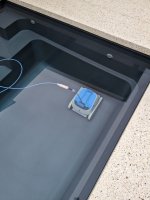- Mar 5, 2020
- 3,221
- Pool Size
- 66000
- Surface
- Plaster
- Chlorine
- Salt Water Generator
- SWG Type
- Astral Viron V35
That's quite interesting, I like the idea of this Red Sea CH test. Looks more fiddly, but it also offers a 5ppm accuracy. Seems to cost about 65AUD for 75 tests. That's actually alright. The CCL test gives me 70 tests with 25ppm accuracy for 40AUD. You could probably reduce the sample size from 5ml to 2.5ml and get 150 tests out of the Red Sea kit with 10ppm accuracy (5ppm might be required for fish, but 10ppm should definitely be enough for a pool). I also like the idea of the more quantitative titration, not having to rely on reproducible drop size. And you won't have a problem with Mg contamination (which I don't think I have, but who knows what the previous house owner has put into the pool...).
I saw that Red Sea also offers a test to measure Carbonate Alkalinity (CA), not Total Alkalinity (TA). I was wondering if that could offer an indirect method to test for CYA. If you tested both, CA and TA, and know your FC and pH, then you should be able to calculate CYA by using chemgeek's Pool Equations. When using the simplified formula for CA that's behind PoolMath, then you wouldn't even need FC and pH. I would love to get rid of the dreaded black-dot test and replace it with a quantifiable titration.
I saw that Red Sea also offers a test to measure Carbonate Alkalinity (CA), not Total Alkalinity (TA). I was wondering if that could offer an indirect method to test for CYA. If you tested both, CA and TA, and know your FC and pH, then you should be able to calculate CYA by using chemgeek's Pool Equations. When using the simplified formula for CA that's behind PoolMath, then you wouldn't even need FC and pH. I would love to get rid of the dreaded black-dot test and replace it with a quantifiable titration.
Last edited:



